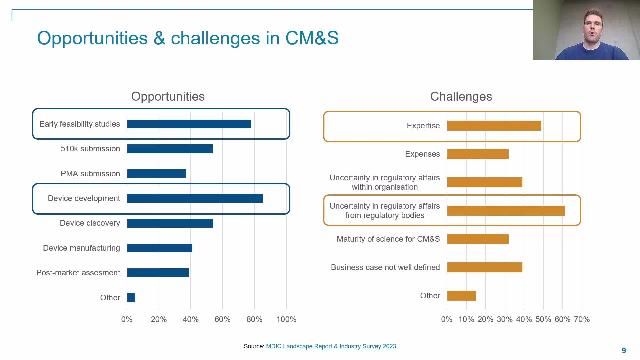In silico medicine is the use of computational models and simulations to develop medical devices. With MATLAB and Simulink for medical device R&D, you can:
- Speed up development and reduce costs by enabling virtual prototyping and testing
- Improve safety and efficacy of medical devices via early feasibility studies with simulations
- Provide supportive regulatory evidence from computational modeling and simulation (CM&S) studies for medical device approvals
“Being able to see the full development, from a blank canvas to the physical thing that will go into clinical trials, in 40 days was fantastic.”
Speed Up Product Development and Reduce Costs
In silico medicine significantly speeds up the design process and reduces costs in medical device R&D by enabling virtual prototyping and testing through computational models. This approach minimizes the need for expensive physical prototypes and early-stage clinical trials. You can identify potential design flaws or failures early in the development process, allowing for quicker iterations and cost savings.
Improve Medical Device Safety and Efficacy
In silico medicine improves the safety and efficacy of medical devices by enabling thorough safety testing and efficacy evaluation through computational modeling and simulation. These simulations can identify potential safety risks and adverse effects, as well as provide early indications of how effectively a medical device diagnoses or treats a condition. This means you can refine the product design early in the development process and focus on the most promising configurations for clinical trials.
Learn More
Provide Supportive Evidence for Regulatory Approvals
In silico medicine can support regulatory submissions for medical device approvals by providing comprehensive device performance validations, risk assessments, and outcomes from in silico clinical trials. The simulation-based data complement traditional clinical data, showcasing device safety and efficacy, particularly in personalized medicine contexts with different patient populations.
Learn More
- Medical Devices Speaker Series 2023: How Cloud-Based In Silico Clinical Trials Accelerate Diabetes Monitoring Device Development (21:32)
- Medical Devices Speaker Series 2023: De-risking and Accelerating Physiological Closed-Loop Control (PCLC) Using Model-Based Design (24:26)
- Technology Trends and Standards in the Medical Devices Industry (41:37)
In Silico Medicine Model Examples
Get started with MATLAB and Simulink for in silico medicine using the example models below.

Medical Ventilator Model in Simscape
This example shows a positive airway pressure (PAP) medical ventilator system with a lung model. It provides a starting point for designers working on medical ventilators and PAP devices.

Cardiovascular System in Simscape with ECMO Machine
The cardiovascular model lets you simulate the flows and pressures of the human cardiovascular system. You can use the model for the development of ECMO machines and heart-lung machines.

Artificial Pancreas Using Fuzzy Logic Controller
This example shows you how to design and optimize a fuzzy inference system (FIS) tree to control an artificial pancreas. You can use the model in the development of continuous glucose monitoring (CGM) systems and insulin pumps.

Dialysis Machine in Simulink
This model shows an ultrafiltration control system for a hemodialysis machine with Simulink and Stateflow. You can use the model in the development of dialysis machines.

Model-Based Design and Verification for Infusion Pump
This model shows an infusion pump with a control system for the flow. You can use it in the verification and validation of infusion pumps and other safety-critical medical devices.

Electrophysiological Heart Model with Pacemaker in Simulink
This model shows an electrophysiological heart with a pacemaker in Simulink. You can use the model in the development of pacemakers and other cardiac rhythm management (CRM) devices with closed-loop testing




